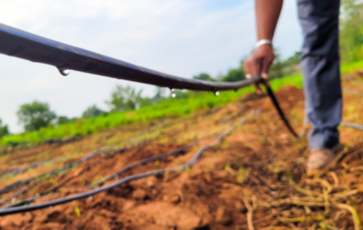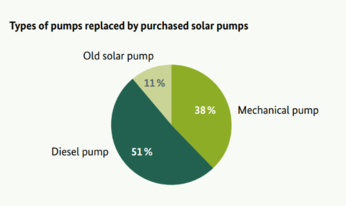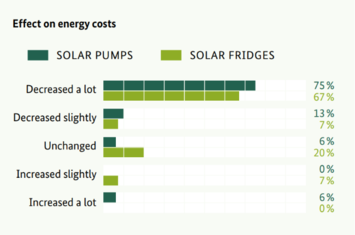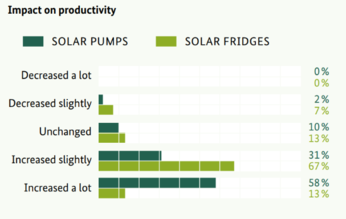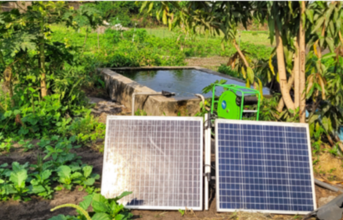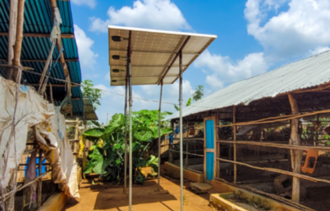Knowledge fuels change - Support energypedia!
For over 10 years, energypedia has been connecting energy experts around the world — helping them share knowledge, learn from each other, and accelerate the global energy transition.
Today, we ask for your support to keep this platform free and accessible to all.
Even a small contribution makes a big difference! If just 10–20% of our 60,000+ monthly visitors donated the equivalent of a cup of coffee — €5 — Energypedia would be fully funded for a whole year.
Is the knowledge you’ve gained through Energypedia this year worth €5 or more?
Your donation keeps the platform running, helps us create new knowledge products, and contributes directly to achieving SDG 7.
Thank you for your support, your donation, big or small, truly matters!
Results-Based Financing Mechanism for Productive Equipment Sales in Benin
Results-Based Financing Mechanism for Productive Equipment Sales in Benin
Project Approach
The overall electrification rate in Benin is relatively low with only 42 % of the population having access to electricity in 2021. The number is even lower in rural areas, where only around 18 % of households have access to electricity. The energy access challenge sits at the intersection of water access, agricultural development, and livelihoods, and is a bottleneck for economic growth. Solar productive use (PU) technologies have the potential to revolutionize irrigation practices in rural areas, and increasing crop yields. They can also power cold storage facilities, reducing food waste and increasing the shelf life of perishable goods.To address this challenge, GBE Benin introduced a market-based approach by bringing together an eco-system of actors, including the solar companies, microfinance institutions (MFIs), agricultural coaches, and the productive end-users of solar energy. The targeted end-users are farmers that produce cash crops or other agricultural products and need solar appliances for irrigation or for drying agricultural products, as well as shop-owners who need solar fridges to sell ice water, fresh drinks, and cold products.
The intervention is active nationwide in rural areas in Benin. It contributes to raising awareness and demonstrating the feasibility of solar energy technologies for productive use with the longterm objective of creating a competitive market environment for solar PU appliances.
The cornerstone of GBE Benin’s approach includes a results-based financing (RBF) mechanism that was launched in August 2020. The RBF provides subsidies to solar companies selling and installing solar PU appliances. The incentives are paid out after the solar PU appliance has been installed, audited, and verified by an independent expert. This verification protocol also serves as a quality control process, which is essential to build market confidence. The subsidy serves to de-risk the market for solar companies to commercialize innovative solar PU appliances and venture into remote areas.
In addition to the financial incentive on the supply side, on the demand side, the project organizes awareness raising campaigns in collaboration with agricultural cooperatives, networks of agricultural extension officers and local authorities. For end-users lacking the initial funds to invest in solar installations, the project facilitates access to credits through partnerships with MFIs.
Methodology of Data Collection
Data for this case study report was collected through a review of project documents, eight qualitative interviews with representatives from the Beninese Agency for Rural Electrification and Energy Management (ABERME), three solar companies (BAHAAU, Jesuton, and ARESS), one solar fridge owner and four representatives from GIZ. Furthermore, a quantitative survey was conducted targeting 133 end-users, who installed a solar-powered device by the end of 2022 (some of them have even more than one appliance). Out of the contacted end-users, 69 responded to the survey (52 owners of solar pumps, 15 solar fridges, 1 solar dryer, 1 electrical appliance for non-agricultural production).
While this is a solid response rate with more than half of the 133 end-users contacted, the representativeness of the results is at the same time limited by many missing responses. The case study was conducted between February and May 2023. At that time, some project activities were still ongoing. As a result, the impacts captured are not exhaustive.
Key Findings
Project Achievements
Four solar companies benefitted from the RBF-mechanism introduced by GBE (BAHAAU, Jesuton, ARESS, and Precis Services) and used it to sell primarily solar pumps and solar fridges. Two of these solar companies adopted a Pay-As-You-Go (PAYG) model for the sale of solar fridges, by offering these devices against a small down payment (generally 10 %) and the payment of the remaining price in regular monthly instalments. More than half of the surveyed users who purchased solar fridges (8 out of 15) received first-time access to electricity through the appliance.This was the case for only 29 % of the surveyed 52 owners of solar pumps. Roughly half of the remaining 37 users acquired the solar pumps to replace a diesel incumbent, while the rest replaced mechanical pumps (38 %) and old solar systems (11 %) as reflected in figure 1.
The use of solar appliances, such as solar fridges or solar pumps, is often more cost-effective than appliances that use conventional energy sources. When asked about energy cost savings, 75 % of the owners of solar pumps and 67 % of the solar fridge buyers confirmed that their energy costs decreased a lot, thanks to the solar appliance, as shown in figure 2. Energy cost savings can have a positive spillover effect on business productivity, as end-users often use the budget freed up from energy expenditure to reinvest in improvingtheir businesses.
Use cases for solar fridges, on the other hand, range from bars, restaurants, hotels, to fish shops. Solar fridges/ owners offer new products, such as ice and cold drinks to increase their sales. On occasions, the solar fridges come with a mobile phone charging kit that can be used for phone charging business.
Intermediate Impact
The achievements described above have contributed to a significant improvement in the development of the end-users’ business activities. For instance, farmers now have more time, money, and energy to invest in their crops, to diversify their farming activities, grow better quality products, and increase their sales.
In addition to energy cost savings, solar PU appliances also have a time-saving impact. For example, diesel pump users in rural areas often travel to nearby cities to procure fuel and spend a lot of time resolving technical issues when the pump breaks down. By replacing diesel by solar water pumps (SWP), the end-users can free up time for other income-generating activities. 89 % of the surveyed solar pump owners and 80 % of the surveyed owners of solar fridges have been able to increase their productivity. Interestingly, the share of those who saw a large increase (instead of just a slight increase) is much higher in case of the solar pumps than for the solar fridges as shown in figure 3.
Through increasing their productivity and developing additional sources of income, as well as through the achieved reductions in energy costs, 93 % of solar pump owners have been able to increase their income either a lot (54 %) or slightly (39 %). Out of the surveyed owners of solar fridges, 67 % have registered an increase in income either a lot (13 %) or slightly (53 %).
It can be concluded that the impacts achieved in terms of energy cost reductions, productivity gains and increases in income are more pronounced in the case of solar pumps than solar fridges. As a result of these improvements, almost half of the beneficiaries have even been able to create new jobs, such as hiring additional labour force during cultivation or harvest (in the case of farmers) or salespersons (in the case of small businesses). This percentage is almost identical for the users of solar pumps and solar fridges. Finally, the increased availability of products, such as fresh drinks and fish, has contributed to improved access to amenities for the rural population.
Climate Impacts
Following the calculation methodology of the United Nations Framework Convention on Climate Change (UNFCCC), the installations described above are estimated to mitigate 102.58 t CO2 e/a in the year of installation by avoiding and/or replacing the use of fossil fuels. This is roughly equivalent to the annual CO2 emissions of more than 73 medium-sized cars in Germany.
Challenges in Project Implementation
The following challenges were identified during the implementation of the project:
- The search for appropriate appliances that meet the market needs was a challenging process for the private sector. At the time of the RBF‘s initial implementation, only a few solar PU appliances, with the required quality, were available in Benin. The GBE project established links between distributors and manufacturers to introduce new brands and products that meet the demand
- The cost of importing solar appliances is high due to low quantities and high custom taxes. Due to the lack of capital, most of the solar companies struggle to import solar products in large quantities, which would reduce the unit prices.
- Under the scope of the RBF, only tested and certified solar products were eligible for subsidy. While these appliances have a longer lifespan and are more resistant, most end-users still find the initial investment required unaffordable. Furthermore, the market in Benin is unfavourably skewed against solar energy due to strong fossil fuel subsidies and other international funders’ support in diesel or LPG-powered appliances. Continuous awareness raising and demonstration of quality and its link to productivity is therefore key to building market confidence.
- The lack of quality standards at the national level puts at risk the solar market, which could be flooded with low quality solar products, now that the RBF-scheme has come to an end.Moreover, the installation-quality of solar PU appliances is inconsistent, since often end-users refuse quality mounting or earthing to lower the cost. This, eventually, has an impact on the safety and lifetime of the system. This also requires awareness raising of the negative impact of low-quality installations on the users’ businesses.
Finally, the verification process of the installations and skew clients’ perception (e.g., thinking that there is a project paying the solar companies, and therefore, become reluctant to pay) has led to dissatisfaction at the level of the solar companies. Nevertheless, the GBE team has successfully considered feedback and comments from the solar companies for the verification and monitoring of the rest of the solar installations.
Lessons Learned
In a nascent market in Benin, financial incentives are not enough for the solar PU sector to reach scale. Financial mechanisms must therefore go hand-in-hand with Technical Assistance (TA) such as training of technicians and staff of solar companies on installation, marketing, remote monitoring, etc., and awareness raising for end-users. Furthermore, the fact that the incentives to the solar companies are results-based and only paid out after installation and verification of the appliances, means that solar companies have to look for capital to finance their stock / PAYG-loan portfolio. This is a challenge for smaller solar companies, which therefore require investment facilitation for this purpose.
The PAYG-concept adopted by two solar companies for the sale of solar fridges has offered end-users a financing model adapted to their financial capabilities by not having to pay the entire price up-front and is therefore a suitable complement to the RBF approach. Companies offering PAYG can reach a larger population by supporting them to overcome the capital barrier. Furthermore, high-level coordination with public partners and other development finance institutions is necessary to prevent sending mixed signals to the market by double-subsidizing competing energy sources. In addition, supporting public partners in developing national-level standards and certification can have a significant impact on quality control. Moreover, the facilitation of dialogue between solar companies and end-users is important to develop adequate sales mechanisms and after-sales services for solar.
Sustainability of the Intervention
Quality control, warranty requirements, and after-sales service are three pillars of sustainability of GBE’s RBF approach. It is done at two levels:
For one, the quality of the appliances is ensured through the eligibility requirements of the RBF facility. For another, the quality of installations is ensured through the verification process, upon which the RBF-incentive is paid to the solar companies. Furthermore, two to three years of warranty are required by the RBF-scheme. This ensures the functioning of the systems beyond the average payback period of most solar PU appliances.
Finally, GBE ensures after-sales service through providing a remote monitoring incentive and carrying out sustainability surveys. Apart from these measures implemented by the GBE project the end-users have been sensitised by the solar companies on the need of carrying out simple preventive maintenance tasks and battery replacement. This has included raising awareness on the need to save money to pay for any maintenance or repairs after the warranty period. The ongoing relationship and cooperation between end-users and solar companies will play a key role in solving any technical issues in the operation and functioning of the solar installations.
Conclusion and Outlook
GBE’s approach has successfully supported four solar companies in introducing solar PU technologies on the market in Benin and in demonstrating their feasibility and socio-economic benefits. End-users (both shopkeepers and farmers) have already started purchasing further solar water pumps and solar fridges to expand their businesses and increase their income. These additional installations have taken place without project support, using the PAYG-model, or from the income generated by the solar PU appliances purchased in the scope of the GBE-project. At the same time, the solar installations have attracted the interest of other end-users who are willing to buy the installations for the first time. Up-scaling of the intervention is already taking place and will eventually grow further. In fact, 94 % of the survey respondents confirmed that other end-users are interested to learn more about solar appliances.
Finally, digital innovation has the potential to contribute in scaling-up the deployment of solar PUE appliances. For example, two solar companies already integrate remote monitoring technologies in their operation to ensure better after-sales service and improve the repayment rate. This increases their ability to offering PAYG-financing, thereby increasing their outreach. At the same time, digitalisation is not only essential for the solar sector to reach scale, but also for development partners such as GIZ to lower the transaction costs of their financing facilities.
Further Information
- Benin Energy Situation
- Promoting Access to Finance
- Financing and Funding Portal
- Results-based Financing


